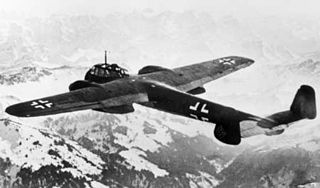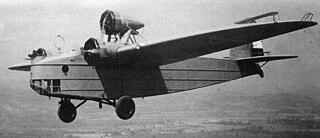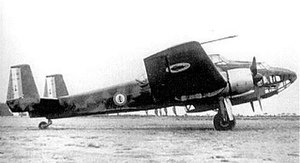Design
The Do 12 was a high-wing monoplane, of usual Dornier all-metal construction, with a two-spar, trapezoidal wing, whose trailing edge was very strongly rounded at the root. The fuselage was of rectangular cross-section.
A storage area was in the nose, where equipment, including anchors, could be kept. Behind it, the open cockpit had two side-by-side seats, with optional dual controls. In the cabin, there were two more seats and a storage area, which could also be fitted with bunks for sleeping. Between the cockpit and cabin were nacelles which accommodated the retracted undercarriage wheels, a first for Dornier, which were lowered or raised manually by a crank. The engine sat on a stand high above the wing, alongside two fuel tanks, in pusher configuration.
From the first flight on 23 June 1932, and in the further course of testing, it was obvious that the Argus engine was underpowered, making takeoff distances substantially too long. However, financial difficulties in the company meant that fitting the stronger Gnome-Rhône Titan 5Ke took some time.
Father Paul Schulte, a missionary known as the "Flying Priest", used the Do 12 "D-INEZ" for many years and in his various books it plays an important role.

The Dornier Do 215 was a light bomber, aerial reconnaissance aircraft and later a night fighter, produced by Dornier originally for export, but in the event most served in the Luftwaffe. Like its predecessor, the Dornier Do 17, it inherited the title "The Flying Pencil" because of its slim fuselage. The successor of the Do 215 was the Do 217.

The Junkers W 34 was a German-built, single-engine, passenger and transport aircraft. Developed in the 1920s, it was taken into service in 1926. The passenger version could take a pilot and five passengers.

The Dornier Do 317 was a prototype German medium bomber of World War II.

The Dornier Do 214 was a proposed large long-range flying boat, developed by Dornier in World War II.

The Albatros Al 101 was a 1930s German trainer aircraft. It was a parasol-wing monoplane of conventional configuration, and seated the pilot and instructor in separate, open cockpits.

The Bréguet 521 Bizerte was a long-range military reconnaissance flying boat built by the French aviation company Breguet.

The Gotha Go 145 is a German World War II-era biplane of wood and fabric construction used by Luftwaffe training units. Although obsolete by the start of World War II, the Go 145 remained in operational service until the end of the War in Europe as a night harassment bomber.

The Dornier Delphin was a 1920s German single-engine commercial flying boat built by Dornier Flugzeugwerke. As well as commercial users, single examples were acquired by the United States Navy and the British Royal Navy for evaluation.

The Dornier Libelle, also designated Do A, was a German open-cockpit, all-metal, parasol wing, monoplane flying boat aircraft, with partly fabric-covered wings. There was three versions of the seaplane version; the prototype, first version, and improved version. A landplane version, built without sponsons and fitted with a fixed tailwheel undercarriage was produced as the Dornier Spatz.

The SET 7 was a military trainer and reconnaissance aircraft that was produced in Romania in the mid-1930s. It was originally designed as a conventional single-bay biplane, with slightly staggered wings, a standard undercarriage with fixed tailskid, and a tandem open-cockpit arrangement for the pilot and instructor or observer. Power was supplied by an Armstrong Siddeley Jaguar radial engine, and from the outset the aircraft was equipped for wireless and photographic reconnaissance duties.

The Dornier Do Y was a trimotor German monoplane bomber of the early 1930s designed by Dornier Flugzeugwerke to an order by the Royal Yugoslav Air Force (RYAF). The Yugoslavs originally intended to use war reparations to pay for them, but ultimately had to use their own funds. Only a pair of aircraft were initially ordered to give the Yugoslavs experience with multi-engine bombers and Dornier failed to sell any more Do Y's. Two improved versions were subsequently built on speculation, but failed to find purchasers until the RYAF bought them in 1935.

The SNCAC NC.211 Cormoran was a large four-engined military transport aircraft for passengers and cargo designed and built by SNCAC from 1945.

The Farman NC.470 was a French twin-engined floatplane designed as a crew trainer for the French Navy. It was used in small numbers for both its intended role as a trainer and as a coastal reconnaissance aircraft at the start of World War II.

The Dornier Do E was a small German flying boat of 1924, designed for reconnaissance missions.

The Dornier Do K was a German commercial passenger and freight monoplane, designed by Claude Dornier and built by Dornier Flugzeugwerke. Only three prototypes of different designs were built and the type was not a commercial success.

The SNCAO CAO.600 was a French prototype twin-engined torpedo-bomber of the Second World War. It was intended to operate from two new aircraft carriers of the French Navy, but only a single example had been completed and flown when the surrender of France in June 1940 ended development of the aircraft.

The Arado Ar 77 was a German twin-engined monoplane, designed as an advanced training aircraft from 1934.

The Albatros L102 / Albatros Al 102, was a German trainer aircraft of the 1930s. It was a parasol-wing landplane, seating the student pilot and instructor in separate, open cockpits. A biplane floatplane version was also built as the Al 102W, with strut-braced lower wings.
The Albatros L 103 / Albatros Al 103 was a German experimental aircraft of the 1930s. It was a parasol-wing landplane of conventional configuration, seating the pilot and flight test observer in separate, open cockpits. The Al 103 was used to test variations in sweepback, dihedral and tailplane area.
The Fukuda Hikari Research-2 Motor Glider was a Japanese civil design which first flew in August 1941. Its gliding performance was encouraging but its development ended as Japan entered World War II in December 1941.
This page is based on this
Wikipedia article Text is available under the
CC BY-SA 4.0 license; additional terms may apply.
Images, videos and audio are available under their respective licenses.



















